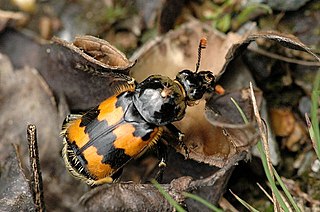
Silphidae is a family of beetles that are known commonly as large carrion beetles, carrion beetles or burying beetles. There are two subfamilies: Silphinae and Nicrophorinae. Members of Nicrophorinae are sometimes known as burying beetles or sexton beetles. The number of species is relatively small, at around two hundred. They are more diverse in the temperate region although a few tropical endemics are known. Both subfamilies feed on decaying organic matter such as dead animals. The subfamilies differ in which uses parental care and which types of carcasses they prefer. Silphidae are considered to be of importance to forensic entomologists because when they are found on a decaying body they are used to help estimate a post-mortem interval.

Burying beetles or sexton beetles, genus Nicrophorus, are the best-known members of the family Silphidae. Most of these beetles are black with red markings on the elytra (forewings). Burying beetles are true to their name—they bury the carcasses of small vertebrates such as birds and rodents as a food source for their larvae; this makes them carnivorous. They are unusual among insects in that both the male and female parents take care of the brood.

Nicrophorus americanus, also known as the American burying beetle or giant carrion beetle, is a critically endangered species of beetle endemic to North America. It belongs to the order Coleoptera and the family Silphidae. The carrion beetle in North America is carnivorous, feeds on carrion and requires carrion to breed. It is also a member of one of the few genera of beetle to exhibit parental care. The decline of the American burying beetle has been attributed to habitat loss, alteration, and degradation, and they now occur in less than 10% of their historic range.
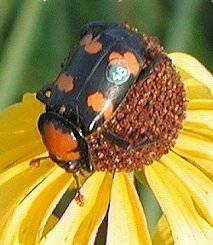
Nicrophorini is a tribe of burying beetles or carrion beetles in the subfamily Silphinae. It was formerly treated as subfamily Nicrophorinae within family Silphidae, but this family was found to be nested in family Staphylinidae in phylogenetic analyses and Silphidae was reassigned as a subfamily Staphylinidae.
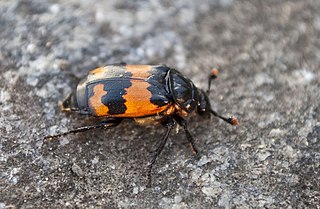
Nicrophorus investigator is a burying beetle first described by the Swedish naturalist Johan Wilhelm Zetterstedt in 1824.

Nicrophorus vespilloides is a burying beetle described by Johann Friedrich Wilhelm Herbst in 1783. The beetles vary widely in size and can present with a range of anywhere from 12 mm to 20 mm in size. They have two conspicuous orange-yellow bands on the elytra. The color of the antennae are an important distinguishing feature, being totally black. The color of their orange and black markings is multifunctional, as they are conspicuous to avian predators. In general, they present a unique ecological niche, which is their evolution of aposematism, or the strategy they use to warn predators through their conspicuous signals. The wing cases of these beetles possess a squarish shape and are notably shorter in length than their abdomens, indicating a distinct physical characteristic of the species.

Nicrophorus germanicus is a burying beetle described by Carl Linnaeus in his landmark 1758 10th edition of Systema Naturae. Males are larger than females and can reach a body length of 27 mm.
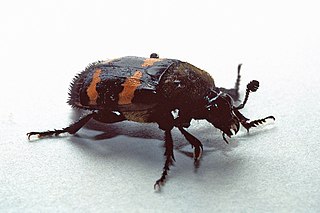
Nicrophorus tomentosus is a species of burying beetle that was described by Friedrich Weber in 1801. The beetle belongs to the family Silphidae which are carrion beetles. The beetles have sensitive antennae that contain olfactory organs. Thus, the beetle can locate dead animals (carcass), and then as the name suggests, can bury them. However, unlike other burying beetles, N. tomentosus does not completely bury these brood carcasses. They instead dig a shallow hole under the carcass and cover it with leaf litter. Recognition of these beetles can be distinguished by its black color with orange markings on the wing covers (elytra).
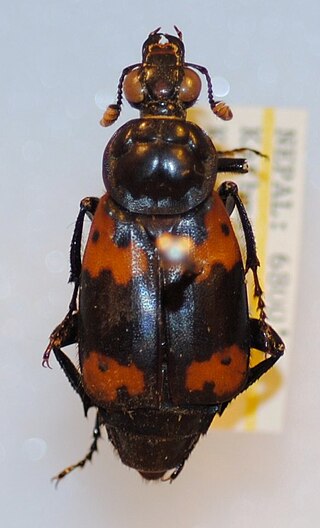
Nicrophorus nepalensis, commonly known as a burying beetle, is widespread across tropical and subtropical countries in Asia. It belongs to the order Coleoptera and the family Silphidae, and is part of the nepalensis species-group, which is the second largest species group within the genus Nicrophorus. N. nepalensis differs from some other beetles in that it exhibits biparental care. Its role as a decomposer is crucial in the energy cycle and energy transformation in the ecosystem.
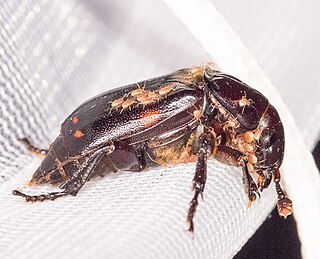
Nicrophorus pustulatus, also known as the pustulated carrion beetle or blistered burying beetle, is a species of burying beetle that was described by Johann Karl Wilhelm Illiger in 1807. This species is native to North America. N. pustulatus exhibits unique habitat utilization and breeding behaviour relative to other members of the genus. This species may be the only described example of a true parasitoid targeting a vertebrate host.
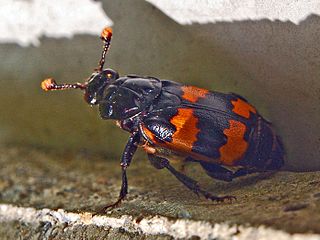
Nicrophorus interruptus is a species of burying beetle or sexton beetle belonging to the family Silphidae subfamily Nicrophorinae.
Nicrophorus carolina is a burying beetle described by Carl Linnaeus in 1771. Its specific name has commonly been misspelled as carolinus.
Nicrophorus confusus is a burying beetle described by Portevin in 1924 and determined, with reservation, to be a junior synonym of Nicrophorus sepultor by Sikes et al. (2008).
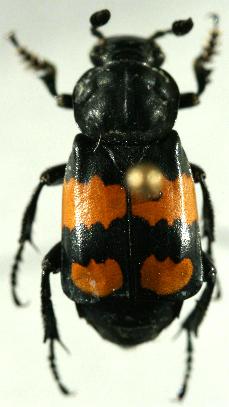
Nicrophorus defodiens is a burying beetle described by Mannerheim in 1846.

Nicrophorus sepultor is a burying beetle described by Toussaint de Charpentier in 1825. It has a Palearctic distribution from Europe to central Asia.

Nicrophorus satanas is a burying beetle described by Edmund Reitter in 1893.

Nicrophorus quadripunctatus is a species of burying beetle that predominates in East Asia. First described by German entomologist Ernst Kraatz in 1877, this beetle has since been the subject of much scientific inquiry—particularly concerning its parental care. Like other burying beetles, N. quadripunctatus inhabit small, vertebrate animal carcasses. This environment provides the beetles with the requisite nutrients for themselves and their offspring. To limit resource theft and predation, the carcass is buried underground. For additional protection, a single, dominant male-female pair guards the carcass cooperatively.

Nicrophorus orbicollis is a nearctic burying beetle first described by Thomas Say in 1825. It is a member of the genus Nicrophorus or sexton beetles, comprising the most common beetles in the family Silphidae. This species is a decomposer feeding on carcasses of small dead animals. N. orbicollis can be used for scientific research both medically and forensically.

Poecilochirus is a Holarctic genus of mites in the family Parasitidae. They are relatively large and often found on rotting corpses, where they are transported by beetles. Deuteronymphs are characterized by two orange dorsal shields and in many species a transverse band on the sternal shield. The juvenile development consists of a larval stage, protonymph, and deuteronymph, but no tritonymph. Females are smaller than males. Males guard female deuteronymphs shortly before these mate, and pairs mate venter-to-venter.

Oiceoptoma noveboracense is a member of the family Silphidae, or carrion beetles, which feed on decaying organic matter such as dead animals. Its common name is the margined carrion beetle, from the orange-red margins on the pronotum, which are helpful when identifying this species. The larva is typically light brown to red and also has vertical ridges on its thorax like the adult. This diurnal beetle can be found mainly in the spring into the fall, and it has a strong preference towards a deciduous forest habitat. The primary forensic importance of this beetle is its ability to use the succession of insect fauna to provide confirmation of postmortem intervals.

















